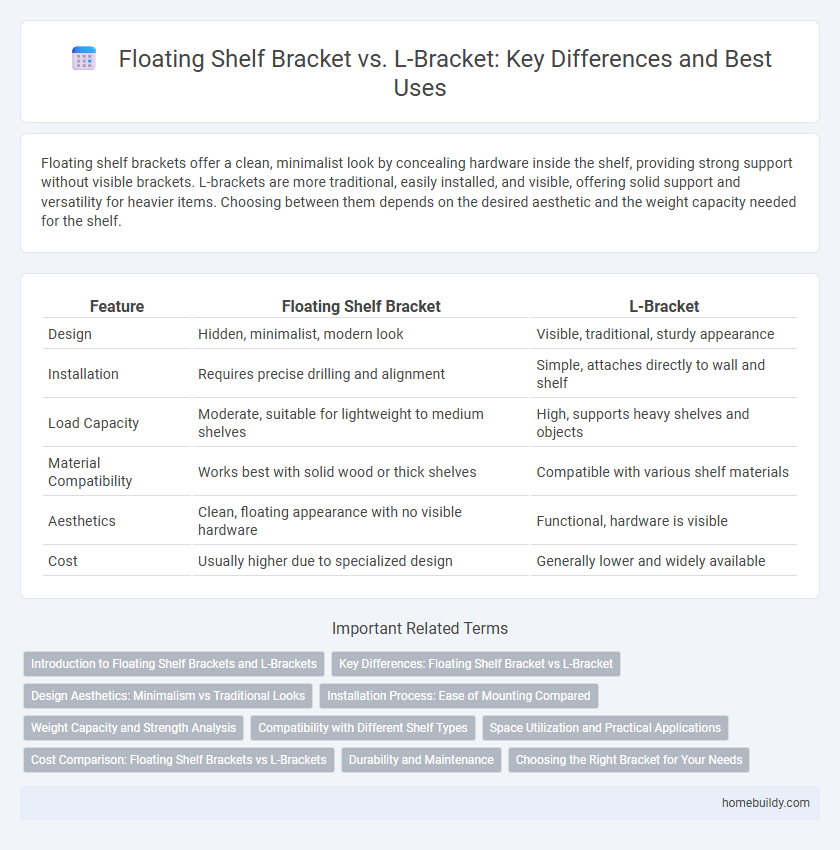Floating shelf brackets offer a clean, minimalist look by concealing hardware inside the shelf, providing strong support without visible brackets. L-brackets are more traditional, easily installed, and visible, offering solid support and versatility for heavier items. Choosing between them depends on the desired aesthetic and the weight capacity needed for the shelf.
Table of Comparison
| Feature | Floating Shelf Bracket | L-Bracket |
|---|---|---|
| Design | Hidden, minimalist, modern look | Visible, traditional, sturdy appearance |
| Installation | Requires precise drilling and alignment | Simple, attaches directly to wall and shelf |
| Load Capacity | Moderate, suitable for lightweight to medium shelves | High, supports heavy shelves and objects |
| Material Compatibility | Works best with solid wood or thick shelves | Compatible with various shelf materials |
| Aesthetics | Clean, floating appearance with no visible hardware | Functional, hardware is visible |
| Cost | Usually higher due to specialized design | Generally lower and widely available |
Introduction to Floating Shelf Brackets and L-Brackets
Floating shelf brackets provide a concealed mounting solution that creates the illusion of a shelf without visible supports, ideal for minimalist and modern interiors. L-brackets offer a more straightforward, visible support system with an angled design, enhancing stability for heavier loads or traditional decor. Choosing between floating shelf brackets and L-brackets depends on aesthetic preference and load-bearing requirements.
Key Differences: Floating Shelf Bracket vs L-Bracket
Floating shelf brackets are designed for hidden installation, creating a seamless, modern look by supporting shelves internally without visible hardware, whereas L-brackets are external, offering exposed support with a right-angle metal design for maximum stability. Floating brackets typically require precise wall anchoring and stud placement to bear weight efficiently, while L-brackets provide more versatile mounting options and can support heavier loads with ease. The choice between the two depends on aesthetic preference, weight requirements, and installation complexity.
Design Aesthetics: Minimalism vs Traditional Looks
Floating shelf brackets offer a sleek, minimalist design by concealing support hardware, creating an uncluttered and modern visual appeal ideal for contemporary interiors. In contrast, L-brackets provide a traditional look with visible metal supports that emphasize functionality and add a rustic or industrial charm to a space. Choosing between floating and L-brackets depends on whether the design priority is seamless minimalism or classic structural visibility.
Installation Process: Ease of Mounting Compared
Floating shelf brackets offer a streamlined installation process by concealing hardware within the wall, requiring precise measurements and secure wall anchors for a seamless appearance. L-brackets are typically easier to mount with visible hardware, involving fewer steps and less precision, making them ideal for quick setups on various surfaces. Both options demand appropriate tools, but floating brackets provide a cleaner aesthetic at the expense of a more complex mounting procedure.
Weight Capacity and Strength Analysis
Floating shelf brackets typically offer higher weight capacity and a cleaner appearance due to concealed mounting, supporting loads of up to 50-100 pounds depending on material and installation quality. L-brackets, while more visible, provide robust strength with simpler installation and can often support heavier weights exceeding 100 pounds when anchored properly into studs. The choice between floating and L-brackets hinges on balancing aesthetic preference with the specific load requirements and wall integrity.
Compatibility with Different Shelf Types
Floating shelf brackets offer seamless compatibility with modern, minimalist shelves, supporting materials like glass, wood, and acrylic without visible hardware for a clean appearance. L-brackets provide versatile support for a wider range of shelf types, including heavy wood, metal, and stone, ensuring stability with obvious mounting points. While floating brackets emphasize aesthetics for lightweight to medium loads, L-brackets prioritize robust structural compatibility across various shelf designs.
Space Utilization and Practical Applications
Floating shelf brackets maximize space utilization by creating a clean, modern look with invisible support, making them ideal for minimalist interiors and tight spaces. L-brackets offer versatile practical applications through visible support and increased load capacity, suitable for heavy or irregularly shaped objects. Choosing between the two depends on balancing aesthetic preferences with the required strength and shelf usage.
Cost Comparison: Floating Shelf Brackets vs L-Brackets
Floating shelf brackets typically cost between $10 and $30 per bracket, offering a sleek, modern look with hidden supports, while L-brackets are more budget-friendly, ranging from $5 to $15 each and providing visible, sturdy support. Installation costs may vary as floating brackets often require precise wall anchoring and professional installation, increasing overall expenses. For cost-conscious projects, L-brackets present a practical option, whereas floating shelf brackets suit higher-end designs valuing aesthetics over budget.
Durability and Maintenance
Floating shelf brackets, designed with concealed mounting systems, offer superior durability by distributing weight evenly across the wall, reducing stress on both the shelf and the bracket compared to L-brackets. L-brackets, while easy to install and maintain due to their exposed nature, may corrode faster if not made from rust-resistant materials and require regular tightening to ensure stability. Maintenance demands for floating shelf brackets are generally lower, as their hidden hardware is less exposed to environmental factors that cause wear and tear.
Choosing the Right Bracket for Your Needs
Floating shelf brackets offer a sleek, minimalist look by concealing supports inside the shelf, ideal for modern interiors and lightweight items. L-brackets provide robust external support suitable for heavier loads and practical applications, making them a preferred choice for garages or utility rooms. Selecting the right bracket depends on load capacity requirements, desired aesthetic, and installation environment to ensure both functionality and style.
Floating shelf bracket vs L-bracket Infographic

 homebuildy.com
homebuildy.com